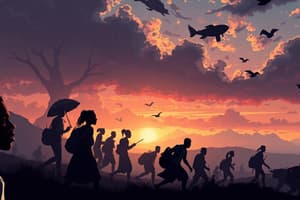Podcast
Questions and Answers
What is the first wave of the Great Migration?
What is the first wave of the Great Migration?
- 1910-1930 = 1.6 million (correct)
- 1950-1970 = 2 million
- 1910-1970 = 6 million (correct)
- 1930-1950 = 4 million
Racism in the North includes ________ and housing segregation.
Racism in the North includes ________ and housing segregation.
violence
What narrative perspective is used in the book?
What narrative perspective is used in the book?
omniscient narrator
Who is Pilate in the story?
Who is Pilate in the story?
What does the character Ruth struggle with?
What does the character Ruth struggle with?
What motivates Macon Dead's behavior?
What motivates Macon Dead's behavior?
Milkman is interested in flying.
Milkman is interested in flying.
Our names connect us to our ________.
Our names connect us to our ________.
What does the concept of love represent in the book?
What does the concept of love represent in the book?
What do names signify in the context of the story?
What do names signify in the context of the story?
Morrison's storytelling assumes familiarity with the characters.
Morrison's storytelling assumes familiarity with the characters.
What significant events mark Milkman's journey?
What significant events mark Milkman's journey?
What motivates the fight involving Milkman?
What motivates the fight involving Milkman?
What is the theme of incestuous love in the story?
What is the theme of incestuous love in the story?
Flashcards are hidden until you start studying
Study Notes
Great Migration
- First wave occurred between 1910 and 1930, with 1.6 million African Americans moving.
- By 1970, the total number of migrants reached 6 million, driven by job opportunities and escaping Jim Crow laws, lynchings, the KKK, and sharecropping.
Racism in the North
- Northern racism manifested through violence and housing segregation, particularly through practices like redlining.
Book Information
- Features an omniscient narrator providing multiple shifts in point of view, illustrating changes in time and perspective.
- Themes of displacement address variations in time, place, and character viewpoints.
- Allusions enrich the text, with form following function to integrate the past within the present narrative.
Pilate
- Characterized by the absence of a navel, symbolically linked to the biblical Eve, representing themes of blame and betrayal.
- Deeply cares for her family while bearing societal and personal burdens.
Ruth
- Notable for her late breastfeeding, hinting at themes of attachment and dependence.
Macon Dead
- Exhibits a complex relationship with his father, showing affection yet criticism, especially towards Pilate, who he refers to as a "snake."
- Preoccupied with self-image, wealth, and property, while critical of his wife Ruth.
- Tells stories that weave past experiences into present realities.
Flight
- Mr. Smith’s dramatic fate ("splat") symbolizes the deep impact of disillusionment.
- Milkman’s loss of interest in life stems from realizing the impossibility of flying, reflecting aspirations and disappointments.
Fathers
- Names create a vital connection to paternal heritage, emphasizing identity and legacy.
Love
- Explores the dangers of incestuous love, questioning the feasibility of healthy love relationships.
Naming
- Names signify connections to history and personal lineage, with nicknames embodying stories and affection.
- Street names reflect historical struggles and identity, with terms like "colored" versus "negro" signifying power dynamics surrounding identity.
Elements of Oral Tradition
- Morrison incorporates elements of oral storytelling, presuming familiarity with the characters and tapping into traditional narratives such as slave stories and folk tales.
Milkman
- Portrayed as a pawn in his parents' dynamics, showing possessiveness and passivity, particularly towards racial issues.
- Key life events: social interactions in a barber shop at age 12, sexual experiences at 16, and physical confrontation with Macon Dead at 22, revealing patterns of boredom and predictability.
Ruth's Story
- Macon’s motivations stem from personal grievances related to Ruth’s financial decisions tied to him and Dr. Foster.
- Milkman's internal conflict during a fight with his father is characterized by dual feelings of sorrow and pride as he seeks both liberation from and connection to paternal influence.
Incestuous Love
- Examines the troubling relationships between Milkman and Hagar, and Ruth with her father, raising questions about healthy boundaries in love.
Studying That Suits You
Use AI to generate personalized quizzes and flashcards to suit your learning preferences.




